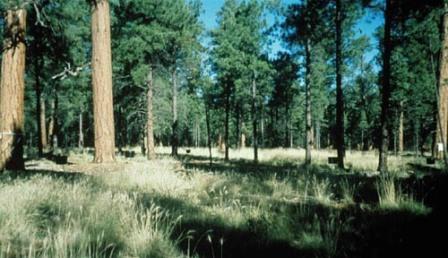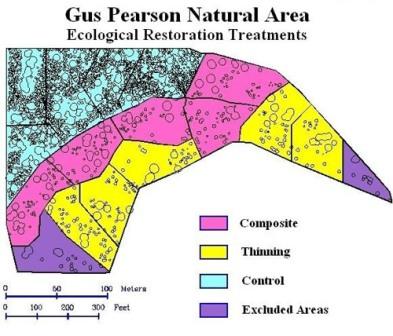Overview
Initiated in 1992 with National Science Foundation funding, the Gus Pearson Natural Area Restoration was an experimental project of Nothern Arizona University’s Ecological Restoration Institute and is located approximately 7 miles (20 km) northwest of Flagstaff, AZ. The original experiment’s aim was to compare three treatments: 1) tree thinning to emulate predisruption forest structure, followed by fuel reduction and prescribed burning (composite); 2) tree thinning only, without fire (thinning); and 3) control. The study also attempted to examine the response of the treatments to different “patch types” at the site, including presettlement stands, postsettlement stands, and remnant grassy patches. GPNA is the site of the Ecological Restoration Institute’s oldest ecological restoration treatments utilizing thinning of small trees to emulate presettlement forest structure prior to reintroducing low-intensity fire (though the study site itself had to be decommissioned as a part of the GPNA to allow for cutting trees).
Quick Facts
Project Location:
Unnamed Road, Flagstaff, AZ 86001, USA, 35.22969916259141, -111.6959339580078
Geographic Region:
North America
Country or Territory:
United States of America
Biome:
Temperate Forest
Ecosystem:
Temperate Forest - Coniferous
Area being restored:
4 Hectares
Project Lead:
Nothern Arizona University's Ecological Restoration Institute
Organization Type:
University / Academic Institution
Location
Project Stage:
Implementation
Start Date:
1992-01-01
End Date:
2014-01-01
Primary Causes of Degradation
Mining & Resource Extraction, OtherDegradation Description
Aside from some light logging in 1894, the site has never been commercially harvested, and so it retained its complement of mature ponderosa pines, as well as a dense growth of young pines originating from the seed crop of 1919. The absence of logging and the growth of young pines caused an accumulation of excessive fuel loads, creating hazardous fire conditions.
Reference Ecosystem Description
Open, park like ponderosa forest with well-developed grassland and frequent low intensity fire regime. The natural area originated as a control site, a remnant of virgin forest to be used for comparison against other studies in the Fort Valley Experimental Forest. The site was heavily grazed by domestic livestock prior to the establishment of the station, which caused the interruption of the fire regime.
Project Goals
The goal of the composite treatment was to recreate as closely as possible the structure and function of a ponderosa pine forest prior to Euro-American settlement and the initiation of fire exclusion (about 1876), and the small size of the project area allowed for the use of relatively labor-intensive methods to effect this result. The original experiment’s aim was to compare three treatments: 1) tree thinning to emulate predisruption forest structure, followed by fuel reduction and prescribed burning (composite); 2) tree thinning only, without fire (thinning); and 3) control. The study also attempted to examine the response of the treatments to different “patch types” at the site, including presettlement stands, postsettlement stands, and remnant grassy patches.
Monitoring
The project does not have a monitoring plan.
Stakeholders
The United States Forest Service and specifically the Coconino National Forest owns Gus Pearson Natural Area, the Rocky Mountain Research Station, and the School of Forestry at Northern Arizona University. By the early 1990s the Forest Service had become increasingly concerned about increasing fuel loads and decreasing forest health in the ponderosa pine forest type. The Forest Service decommissioned a small area as a firebreak adjacent to the buildings of the experimental station when the project was initiated.
Description of Project Activities:
First most of the small, postsettlement trees were cut and removed from the site, with some left to replace trees which had died or been cut since 1876. Recent leaf litter was raked aside, and the accumulated duff from the past century was removed, then the recent litter was replaced. Finally, to replicate the composition of fine fuels which would have been in place in presettlement times, native grass hay from nearby Hart Prairie was collected and scattered across the site before burning. The composite units were burned in the fall of 1994, and have since been repeatedly burned on a four-year rotation. The thinning units received the same level of tree thinning, but had none of the forest floor manipulation, and of course were not burned.
Ecological Outcomes Achieved
Eliminate existing threats to the ecosystem:
More than a decade after the treatments were completed, the composite and thinning treatments appear to have made substantial recovery towards the structure and functioning of an undisturbed presettlement ponderosa pine forest. The mixture of large, yellow-bark pines and young, vigorous blackjacks in clumps across the site approximates the structure of the original forest, and the open spaces between clumps are dense with native grasses (including squirreltail, mountain muhly, Arizona fescue, and pine dropseed) and forbs (such as American vetch, Wheeler's thistle, and silvery lupine). The strongest response in the understory vegetation was seen in the patches where all the young postsettlement trees were removed.
Factors limiting recovery of the ecosystem:
The project at Gus Pearson was driven by a desire on the part of Forest Service managers and scientists to develop methods to apply management techniques on larger landscape scales. Because of its small size (4 hectares) the work at Gus Pearson Natural Area was able to accomplish significant restoration that required detailed labor-intensive methods. The applicability of such intensive methods on larger scales has always been a question for researchers.
Socio-Economic & Community Outcomes Achieved
Economic vitality and local livelihoods:
By exploring solutions to the health crisis in southwestern ponderosa pine forests, the Gus Pearson project set researchers on a path toward successful ecological restoration techniques in these ponderosa forests. Restoration experiments have provided a scientific basis for political decisions being made by forest managers to thin areas in Urban-Wildland interface in similar forest types for fire protection. In nearby Flagstaff, Arizona, the experiments at Gus Pearson provided necessary understanding to encourage strategic thinning projects to protect the city from the threat of wildfire.
Key Lessons Learned
While originally conceived of as a project for fire protection, the restoration experiment was developed in part because of the results from the interval burning studies. Other projects in the area in the 1980s and early 1990s suggested that prescribed fire alone was insufficient to restore presettlement forest structure, indicating that additional thinning and then raking of the extensive litter layer away from the bases of large trees would be required. Research at this experimental site has generated valuable insights about stand age structure and the effects of restoration treatments. Fifteen years after thinning, old ponderosa pine trees in the stand continue to respond positively in terms of leaf physiology and insect resistancee. Herbaceous understory vegetation has responded to restoration treatments but the responses differ between patches in the open and under the canopy and among functional groups and species. Other studies have examined the effects of treatments and patch types on soil chemistry, nutrient fluxes, and soil microbes.
Long-Term Management
The long-term strategy is to try to maintain the experiment by maintaining the fenced exclosure, maintain the no-treatment/no-disturbance status of the control area, and burn the thin + burn treatment every 4 years indefinitely into the future.
Sources and Amounts of Funding
300,000+ USD National Science Foundation
NAU-School of Forestry
McIntire-Stennis Funds (cooperative research monies)
Other Resources
Publications (peer-reviewed):
* Bailey, J.D. and W.W. Covington. 2002. Evaluating ponderosa pine regeneration rates following ecological restoration treatments in northern Arizona, USA. Forest Ecology and Management 155:271-278.
Boyle, S.I., S.C. Hart, J.P. Kaye, and M.P. Waldrop. 2005. Restoration and canopy type influence soil microflora in a ponderosa pine forest. Soil Science Society of American Journal 69:1627-1638.
* Covington, W.W., P.Z. Fulé, S.C. Hart, and R.P. Weaver. 2001. Modeling ecological restoration effects on ponderosa pine forest structure. Restoration Ecology 9:421-431.
* Covington, W.W., P.Z. Fulé, M.M. Moore, S.C. Hart, T.E. Kolb, J.N. Mast, S.S. Sackett, and M.R. Wagner. 1997. Restoring ecosystem health in ponderosa pine forests of the Southwest. Journal of Forestry 95(4):23-29.
* Feeney, S.R., T.E. Kolb, W.W. Covington, and M.R. Wagner. 1998. Influence of thinning and burning restoration treatments on presettlement ponderosa pines at the Gus Pearson Natural Area. Canadian Journal of Forest Research 28:1295-1306.
* Fulé, P.Z., and W.W. Covington. 1994. Double sampling increases the efficiency of forest floor inventories for Arizona ponderosa pine forests. International Journal of Wildland Fire 4:3-10.
* Hart, S.C., T.H. DeLuca, G.S. Newman, M. Derek MacKenzie, and S.I. Boyle. 2005. Post-fire vegetative dynamics as drivers of microbial community structure and function in forest soils.; Forest Ecology and Management 220:166-184.
* Kaye, J.P., and S.C. Hart. 1998. Ecological restoration alters nitrogen transformations in a ponderosa pine-bunchgrass ecosystem. Ecological Applications 8:1052-1060.
* Kaye, J.P., S.C. Hart, R.C. Cobb, and J.E. Stone. 1999. Water and nutrient outflow following the ecological restoration of a ponderosa pine-bunchgrass ecosystem. Restoration Ecology 7:252-261.
* Kaye, J.P., S.C. Hart, P.Z. Fulé, W.W. Covington, M.M. Moore and M.W. Kaye. 2005. Initial carbon, nitrogen, and phosphorus fluxes following ponderosa pine restoration treatments. Ecological Applications 15(5):1581-1593.
* Laughlin, D.C., M.M. Moore, J.D. Bakker, C.A. Casey, J.D. Springer, P.Z. Fulé, and W.W. Covington. In press. Assessing targets for restoration of herbaceous vegetation in ponderosa pine forests. Restoration Ecology.
* Mast, J.N., P.Z. Fulé, M.M. Moore, W.W. Covington, and A.E.M. Waltz. 1999. Restoration of presettlement age structure of an Arizona ponderosa pine forest. Ecological Applications 9:228-239.
* Moore, M.M., C.A. Casey, J.D. Bakker, J.D. Springer, P.Z. Fulé, W.W. Covington and D.C. Laughlin. 2006. Herbaceous Vegetation Responses (1992-2004) to Restoration Treatments in a Ponderosa Pine Forest. Rangeland Ecology and Management 59: 135-144.
* Moore, M.M., W.W. Covington, and P.Z. Fulé. 1999. Reference conditions and ecological restoration: a southwestern ponderosa pine perspective. Ecological Applications 9:1266-1277.
* Stone, J.E., T.E. Kolb, and W.W. Covington. 1999. Effects of restoration thinning on presettlement Pinus ponderosa in northern Arizona. Restoration Ecology 7:172-182.
* Wallin, K.F., T.E. Kolb, K.R. Skov, and M.R. Wagner. 2004. Seven-year results of thinning and burning restoration treatments on old ponderosa pines at the Gus Pearson Natural Area. Restoration Ecology 12(2):239-247.
Non peer-reviewed:
* Covington, W.W. 1996. Implementing adaptive ecosystem restoration in western long-needled pine forests. In: Covington, W. Wallace and P.K. Wagner, tech. coord. Conference on adaptive ecosystem restoration and management: restoration of Cordilleran conifer landscapes of North America: Proceedings; 1996 June 6-8; Flagstaff, AZ. Gen. Tech. Rep. RM-GTR-278. Fort Collins, CO, U.S. Department of Agriculture, Forest Service, Rocky Mountain Research and Range Experiment Station: 44-48.
* Kolb, T.E., P.Z. Fulé, M.R. Wagner, and W.W. Covington. 2001. Six-year changes in mortality and crown conditions of old-growth ponderosa pines in ecological restoration treatments at the G. A. Pearson Natural Area. USDA Forest Service Proceedings RMRS-P-22. pp.61-66.
* Machina, L.M., M.M. Moore, and L.E. DeWald. 2003. Herbaceous understory phenology, growth, reproduction, and germination response to forest restoration treatments. Final Report for RMRS-99159-RJVA submitted to Rocky Mountain Research Station, USDA Forest Service, Flagstaff, AZ.




